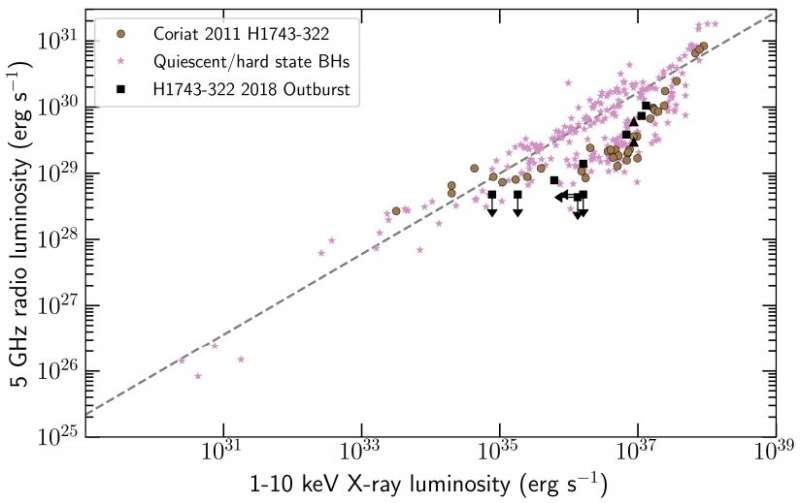October 10, 2019 report
Astronomers investigate a black hole candidate during outburst

Using MeeKAT telescope, astronomers have studied a black hole candidate X-ray binary system known as H1743−322 during an outburst that took place last year. Results of the study, presented in a paper published October 1 on arXiv.org, could help astronomers to untangle the mysteries of black holes existing as part of binary systems.
Black hole X-ray binaries (BHXBs) are binary systems consisting of a black hole orbited by a stellar companion, typically a low-mass, evolved star. In BHXBs, X-rays are produced by material accreting from a secondary companion star onto a black hole primary. Such systems are usually detected in outbursts when the X-ray flux increases significantly.
First detected in 1977, H1743−322 is a black hole candidate assumed to be a BHXB. To date, it has experienced many complete and incomplete outbursts. More recently, in September 2018, observations with INTEGRAL satellite provided evidence that the object was in the early stages of an outburst.
INTEGRAL findings motivated an international team of astronomers led by David Williams of the University of Oxford, U.K., to commence monitoring of the new outburst in H1743−322. Hoping to shed more light into the nature of this BHXB, the scientists observed its outburst using the MeerKAT telescope in South Africa as part of the ThunderKAT Large Survey Project.
"We followed the 2018 outburst of the black hole candidate X-ray binary H1743−322 at 1.284 GHz with the MeerKAT radio interferometer as part of the long term X-ray binary (XRB) monitoring program of the Large Survey Project ThunderKAT," the astronomers wrote in the paper.
As a result, the team detected H1743−322 seven times over the course of the 2018 outburst. All the seven detections show an unresolved point source at the phase center and no transient radio ejecta were observed. The flux density evolved smoothly across the detections, from about 0.69 mJy/beam on September 5 to approximately 2.42 mJy/beam on September 14.
H1743−322 remained in the spectral 'hard' state (dominated by output in hard X-rays at about 100 keV) throughout the outburst. Given that this source most likely never left the 'hard' spectral state, the astronomers labeled the September 2018 outburst as 'hard-only'.
Furthermore, the data reveal that the recent outburst of H1743−322, like previous such events in this system, follows the 'radio-quiet' phase, which is typical for the majority of BHXBs.
"As in previous outbursts, H1743−322 follows the 'radio-quiet' correlation in the radio/X-ray plane for black hole X-ray binaries, and the radio spectral index throughout the outburst is consistent with the 'radio-quiet' population," the paper reads.
The astronomers now plan further monitoring of H1743−322 under the ThunderKAT project, as this source is known to experience outbursts at least every two years. They aim to construct the radio and X-ray light curves of this system and also other sources, in order to develop one of the largest databases of hard-state X-ray binaries.
More information: The 2018 outburst of BHXB H1743-322 as seen with MeerKAT, arXiv:1910.00349 [astro-ph.HE] arxiv.org/abs/1910.00349
© 2019 Science X Network




















